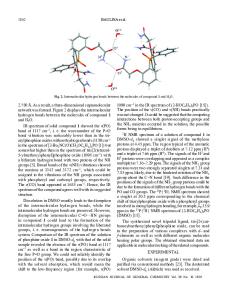Synthesis and Structure of 1,2-Bis(2,6-dimethylphenylphosphino)ethane: A Missing Member of the Phosphine Family
- PDF / 1,030,643 Bytes
- 5 Pages / 595.276 x 790.866 pts Page_size
- 53 Downloads / 331 Views
BRIEF COMMUNICATION
Synthesis and Structure of 1,2‑Bis(2,6‑dimethylphenylphosphino) ethane: A Missing Member of the Phosphine Family Awal Noor1,2,3 · Sadaf Qayyum1,2 · Sher Ali Khan4 Received: 6 February 2019 / Accepted: 18 July 2019 © Springer Science+Business Media, LLC, part of Springer Nature 2019
Abstract A simple synthesis of 1,2-bis(2,6-dimethylphenylphosphino)ethane is reported. Synthesis involves reaction of in situ prepared lithium salt of 2-bromo-m-xylene with 1,2-bis(dichlorophosphino)ethane in diethylether. The title compound, [ C34H40P2], crystallized in the triclinic space group, P-1 with cell parameters: a = 6.977(5) b = 9.186(5) c = 11.629(5) Å, α = 109.880(5) β = 92.993(5) γ = 94.362(5)°, V = 696.4(7) A3, Z = 1. The compound has been characterized by NMR and single crystal X-ray crystal structure analysis and the purity was confirmed by elemental analysis. The solid state data were also calculated by DFT. Graphic Abstract A simple synthesis and structure of 1,2-bis(2,6-dimethylphenylphosphino) ethane, an important but missing member of the phosphine ligand family is reported.
Keywords Ethane · NMR · Phosphine · Single crystal · X-ray analysis
Introduction Electronic supplementary material The online version of this article (https://doi.org/10.1007/s10870-019-00801-9) contains supplementary material, which is available to authorized users. * Awal Noor [email protected]; awal.noor@uni‑bayreuth.de Extended author information available on the last page of the article
Ancillary ligands such as bidentate phosphine ligands have been used to stabilize and/or activate organotransition metal species [1–4]. Since, the early application of 1,2-bis(diphenylphosphino) ethane as chelating phosphine ligands, research efforts have more recently been centered
13
Vol.:(0123456789)
on modifying the organic substituents on the phosphorus atom [5–17]. Thus, properties such as the electronic nature, the steric requirements or solubility of the ligand and their corresponding metal complexes can be fine-tuned to suit the desired application. Numerous simple and efficient methods for the synthesis of bis(diorganophosphino) ethanes bearing alkyl or substituted phenyl groups on the phosphorus atom have been reported [18–21]. It has led to isolation of a large number of bis(diorganophosphino) ethanes ligands, in particular with substituted phenyl groups. Among such ligands where phenyl group bears simple alkyl substituents, a variety of ligands in terms of electronic and steric effects with general formula of R2P(CH2)2PR2 [where R = C 6H 4Me-2, C 6H 4Me-3, C 6H 4Me-4, C 6H 2Me 2-2,3, C 6H 2Me 2-3,5, C 6H 2Me 3-2,4,6, C 6H 2Me 4-2,3,5,6, C 6F 5, C6H4R1-4 (R1 = OMe, Me, NMe2, Cl, CF3), OMe, OPh, C6H4Et-2, C6H4iPr-2 etc.] have been previously synthesized and explored extensively. Surprisingly, a simple 1,2-bis(2,6dimethylphenylphosphino)ethane ligand is not reported to the best of our knowledge. Here, we report a simple synthesis and structure of this ligand.
Results and Discussion The title com
Data Loading...











